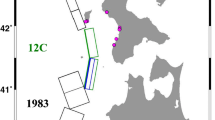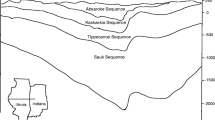Abstract
The Pearl River Mouth Basin is one of the most favorable areas for gas exploration on the northern slope of the South China Sea. Differences of fault patterns between shelf and slope are obvious. In order to investigate the tectonic evolution, five series of analogue modeling experiments were compared. The aim of this study is to investigate how crustal thickness influences fault structures, and compare this to the observed present-day fault structures in the Pearl River Mouth Basin. The initial lithospheric rheological structure can be derived from the best fit between the modeled and observed faults. The results indicate. (1) Different initial crustal rheological structures can produce different rift structures in the Pearl River Mouth Basin. (2) We also model that the Baiyun Sag in the southern Pearl River Mouth Basin may have had a thinned crust before rifting compared to the rest of the basin. (3) The thickness ratio of brittle to ductile crust in southern Pearl River Mouth Basin is less than normal crust, suggesting an initially hot and weak lithosphere. (4) Slightly south of the divergent boundary magma may have taken part in the rifting process during the active rift stage.










Similar content being viewed by others
References
Allemand P, Brun JP (1991) Width of continental rifts and rheological layering of the lithosphere. Tectonophysics 188:63–69
Briais A, Patriat P, Tapponnier P (1993) Updated interpretation of magnetic anomalies and seafloor spreading in the South China Sea: implications for the tertiary tectonics of Southeast Asia. J Geophys Res 98:6299–6328
Brun JP (1999) Narrow rifts versus wide rifts: inferences for the mechanics of rifting from laboratory experiments. Philos Trans R Soc A-Math Phys Eng Sci 357:695–712
Chemenda AI, Yang RK, Stephan JF (2001) New results from physical modeling of arc-continent collision in Taiwan: evolutionary model. Tectonophysics 333:159–178
Chen CM, Shi HS, Xu SC (2003) The condition of oil and gas reservoir formation in the east of Pearl River Mouth Basin (in Chinese with English abstract). Science Press, Beijing
Clift P, Lin J (2001) Preferential mantle lithospheric extension under the South China margin. Mar Petrol Geol 18:929–945
Clift P, Lin J, Barckhausen U (2002) Evidence of low flexural rigidity and low viscosity lower continental crust during continental break-up in the South China Sea. Mar Petrol Geol 19:951–970
Cloetingh SB, Argenio D, Catalano R (1995) Interplay of extension and compression in basin formation: introduction. Tectonophysics 252:1–5
Cobbold PR, Rossello E, Vendeville B (1989) Some experiments on interacting sedimentation and deformation above salt horizons. Bull Sot G&ol Fr 5:453–460
Corti G, Bonini M, Conticelli S (2003) Analogue modeling of continental extension: a review focused on the relations between the patterns of deformation and the presence of magma. Earth-Sci Rev 63:169–247
Davy P, Cobbold PR (1991) Experiments on shortening of a 4-layer model of the continental lithosphere. Tectonophysics 188:1–25
Dominguez S, Lallemand S, Malavieille J (1998) Upper plate deformation associated with seamount subduction. Tectonophysics 293:207–224
Fadaie K, Ranalli G (1990) Rheology of the lithosphere in the East African Rift System. Geophys J Int 102:445–453
Huang CJ, Zhou D, Sun Z (2005) Deep crustal structure of Baiyun Sag, northern South China Sea revealed from deep seismic reflection profile (in Chinese with English abstract). Chin Sci Bull 50:1131–1138
Keep M (2003) Physical modeling of deformation in the Tasman Orogenic Zone. Tectonophysics 375:37–47
Kusznir NJ, Ziegler PA (1992) The mechanics of continental extension and sedimentary basin formation: a simple-shear/pure-shear flexural cantilever model. Tectonophysics 215:117–131
Li PL (1989) Tectonic structures and evolution of the Pearl River Mouth Basin (in Chinese with English abstact). China Offshore Oil Gas Geol 3:11–18
Li P, Rao BC (1994) Tectonic characteristics and evolution history of the Pearl River Mouth Basin (in Chinese with English abstract). Tectonophysics 235:13–25
Liu A, Wu SM (2011) A discussion on the formation of granite in the Pearl River Mouth Basin and its implication to hydrocarbon resource (in Chinese with English abstract). Earth Sci Frontier 18:141–148
Malavieille J, Trullenque G (2009) Consequences of continental subduction on forearc basin and accretionary wedge deformation in SE Taiwan: insights from analogue modeling. Tectonophysics 466:377–394
Nie FJ, Jiang MZ, Wu KQ (2005) Tectono-magmatism and hot fluid flow in the Pearl River Mouth Basin, South China Sea (in Chinese with English abstract). J East China Inst Tecchnol 28:107–112
Pang X, Yang SK, Zhu M (2004) Deep-water fan systems and petroleum resources on the northern slope of the South China Sea (in Chinese with English abstract). Acta Geol Sinica 78:626–631
Pang X, Chen CM, Wu MS (2006) The pearl river deep—water fan systems and significant geological events (in Chinese with English abstract). Adv Earth Sci 21:793–799
Peng DJ, Pang X, Chen CM (2006) The characteristics and controlling factors for the formation of deep-water fan system in South China Sea (in Chinese with English abstract). Acta Sedimentol Sin 24:10–18
Prodehl C, Fuchs K, Mechie J (1997) Seismic-refraction studies of the Afro-Arabian rift system—a brief review. Tectonophysics 278:1–13
Pubellier M, Cobbold PR (1996) Analogue models for the transpressional docking of volcanic arcs in the Western Pacific. Tectonophysics 253:33–52
Shi XB, Zhou D, Qiu XL (2002) Thermal and rheological structures of the Xisha Trough, South China Sea. Tectonophysics 351:285–300
Sun Z, Zhong ZH, Keep M (2009) 3D analogue modeling of the South China Sea: a discussion on breakup pattern. J Asian Earth Sci 34:544–556
Sun Z, Zhou D, Sun LT (2010) Dynamic analysis on rifting stage of Pearl River Mouth Basin through analogue modeling (in Chinese with English abstract). J Asian Earth Sci 21:439–454
Yang Z, Besse J (1993) Paleomagnetic study of Permian and Mesozoic sedimentary rocks from northern Thailand supports the extrusion model for Indochina. Earth Planet Sci Lett 117:525–552
Zhang ZJ, Yu XH, Hou GW (2004) Genetic evolution and depositional filling model of tensional marginal sea basin: take the Pearl River Mouth Basin as an example. Geoscience 18:284–290
Zhang YF, Sun Z, Guo XW (2008) Stretching characteristics and its dynamic significance of the northern continental margin of South China Sea. Sci China Ser D-Earth Sci 51:1–9
Zhong ZH, Wang LS, Li XX (2004) The paleogene basin filling evolution of Qiongdongnan Basin and its relation with seafloor spreading of the South China Sea (in Chinese with English abstract). Mar Geol Quat Geol 24:29–37
Zhou D, Wang WY, Wang JL (2006) Mesozoic subduction-accretion zone in northeastern South China Sea inferred from geophysical interpretations. Sci China Ser D Earth Sci 49:471–482
Zou HP, Li PL, Rao CT (1995) Geochemistry of Cenozoic volcanic rocks in Pearl River Mouth Basin and it’s geodynamic significance (in Chinese with English abstract). Geochimica 24:33–47
Acknowledgments
Funds for this study were provided by the Chinese Natural Science Fundation of China (No. 41206040, No. 41106055), National Key Basic Research Development Plan (2009CB219401), National Science and Technology Major Project (2011ZX05025-002-01).
Author information
Authors and Affiliations
Corresponding author
Rights and permissions
About this article
Cite this article
Zhang, Y.F., Sun, Z. A study of faulting patterns in the Pearl River Mouth Basin through analogue modeling. Mar Geophys Res 34, 209–219 (2013). https://doi.org/10.1007/s11001-013-9185-5
Received:
Accepted:
Published:
Issue Date:
DOI: https://doi.org/10.1007/s11001-013-9185-5




